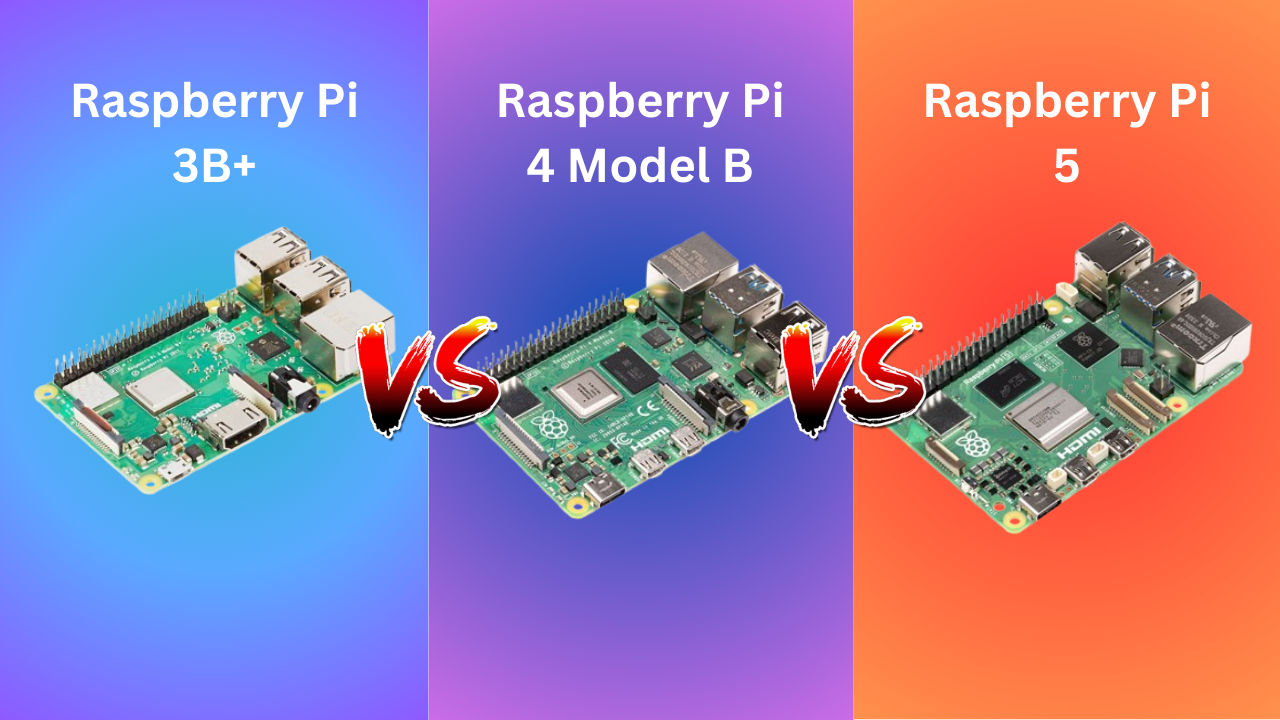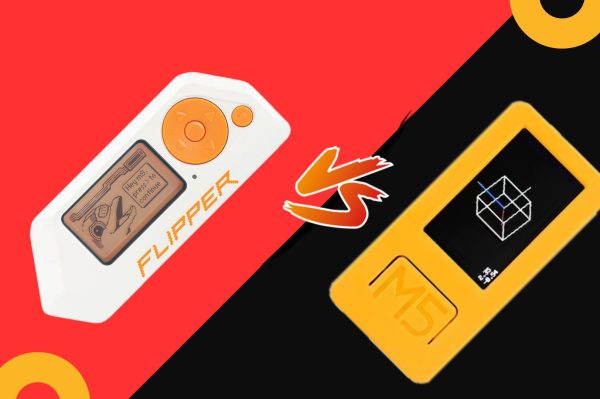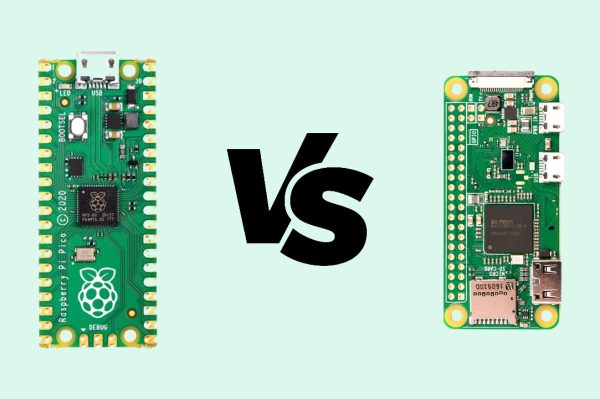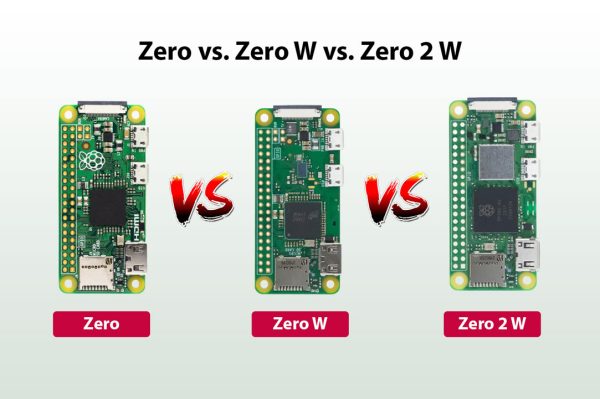
The Raspberry Pi family has become a go-to solution for tech enthusiasts, hobbyists, and professionals looking for a versatile, affordable, and compact computing platform. With each new model, the Raspberry Pi Foundation has pushed the boundaries of what’s possible with these tiny devices. But with multiple options available, it can be tough to decide which one best fits your needs. In this guide, we’ll compare Raspberry Pi 3B+ vs Raspberry Pi 4 vs Raspberry Pi 5 to help you make an informed choice.
Key Specifications: Raspberry Pi 3B+, Raspberry Pi 4, and Raspberry Pi 5
Before diving into a detailed comparison, let’s take a quick look at the technical specifications of each Raspberry Pi model.
| Features | Raspberry Pi 3B+ | Raspberry Pi 4 | Raspberry Pi 5 |
|---|---|---|---|
| Processor | Quad-core Cortex-A53, 1.4 GHz | Quad-core Cortex-A72, 1.5 GHz | Quad-core Cortex-A76, 2.4 GHz + 1.8 GHz |
| RAM Options | 1 GB LPDDR2 | 1 GB, 2 GB, 4 GB, or 8 GB LPDDR4 | 2 GB, 4 GB or 8 GB LPDDR5 |
| Graphics | VideoCore IV | VideoCore VI | VideoCore VII |
| USB Ports | 4x USB 2.0 | 2x USB 3.0, 2x USB 2.0 | 2x USB 3.0, 2x USB 2.0 |
| Ethernet | Gigabit Ethernet (300 Mbps) | True Gigabit Ethernet | True Gigabit Ethernet + PoE Support |
| Wi-Fi | 802.11ac dual-band | 802.11ac dual-band | Wi-Fi 6E |
| Bluetooth | Bluetooth 4.2 | Bluetooth 5.0 | Bluetooth 5.2 |
| Power Supply | 5V/2.5A micro-USB | 5V/3A USB-C | 5V/5A USB-C |
| Video Output | HDMI (Full-size) | 2x micro-HDMI, up to 4K | 2x micro-HDMI, up to 4K@60Hz |
Performance Comparison: Raspberry Pi 3B+ vs Raspberry Pi 4 vs Raspberry Pi 5
Processing Power
When comparing Raspberry Pi 3B+, Raspberry Pi 4, and Raspberry Pi 5, the most noticeable difference lies in their processing capabilities. The Raspberry Pi 3B+ uses a quad-core Cortex-A53 processor running at 1.4 GHz, making it suitable for basic tasks like web browsing, running simple scripts, or using it as a home automation hub.
The Raspberry Pi 4 brings a significant upgrade with a Cortex-A72 processor at 1.5 GHz, delivering nearly three times the performance of its predecessor. This model is perfect for running more complex applications such as media servers, lightweight gaming, and even some AI-based projects.
The Raspberry Pi 5 takes things a step further with a quad-core Cortex-A76 CPU, offering clock speeds of up to 2.4 GHz. This translates to even faster processing, making the Raspberry Pi 5 ideal for demanding applications like real-time data processing, high-resolution media playback, and machine learning projects.
Graphics Capabilities
For those interested in graphics performance, the Raspberry Pi 3B+ features a VideoCore IV GPU, which is sufficient for 1080p video playback. However, for more modern applications, the Raspberry Pi 4’s VideoCore VI supports dual 4K displays, allowing for better performance in multimedia projects.
The Raspberry Pi 5 further enhances graphics with its VideoCore VII GPU, providing smoother 4K@60Hz video playback. This makes it an excellent choice for users looking to build advanced home theater systems or engage in GPU-intensive computing like AI vision applications.
Connectivity: How Do the Models Compare?
Networking and USB Ports
The Raspberry Pi 4 and Raspberry Pi 5 both feature true Gigabit Ethernet, which provides faster network speeds compared to the Raspberry Pi 3B+’s limited throughput (300 Mbps). This makes the newer models more suitable for applications like network-attached storage (NAS) or running a personal cloud server.
Additionally, the Raspberry Pi 4 and Raspberry Pi 5 come with two USB 3.0 ports, offering faster data transfer speeds compared to the USB 2.0-only configuration of the Raspberry Pi 3B+. If you plan to connect external storage drives or high-speed peripherals, these ports are a significant advantage.
Wireless Connectivity: Wi-Fi and Bluetooth
The Raspberry Pi 3B+ and Raspberry Pi 4 support 802.11ac Wi-Fi, but the Raspberry Pi 5 goes a step further with Wi-Fi 6E, offering higher speeds and more reliable connections. This makes it ideal for environments where network performance is critical. The Raspberry Pi 5 also includes Bluetooth 5.2, providing better range and faster data rates for Bluetooth-enabled devices.
Use Cases: Which Raspberry Pi Should You Choose?
- Raspberry Pi 3B+: If you’re looking for a budget-friendly solution for simple projects like IoT applications, digital signage, or retro gaming, the Raspberry Pi 3B+ remains a good choice. It offers sufficient performance for lightweight tasks and is easy on the wallet.
- Raspberry Pi 4: For users needing a versatile device, the Raspberry Pi 4 is a solid option. With multiple RAM choices and a faster processor, it’s ideal for media servers, moderate AI applications, and even running a desktop-like experience with Raspberry Pi OS.
- Raspberry Pi 5: If you want the best performance and are willing to invest in the latest hardware, the Raspberry Pi 5 is the way to go. It’s perfect for power users looking to run advanced AI models, create high-resolution video setups, or use it as a robust server.
Price Comparison: Is It Worth the Upgrade?
- Raspberry Pi 3B+: The most affordable of the three, making it a great entry-level choice for beginners.
- Raspberry Pi 4: Slightly more expensive, but the extra cost is justified by better performance and RAM options.
- Raspberry Pi 5: The highest-priced model, but it offers substantial improvements in speed, graphics, and connectivity.
Conclusion: Raspberry Pi 3B+ vs Raspberry Pi 4 vs Raspberry Pi 5
When it comes to choosing between Raspberry Pi 3B+, Raspberry Pi 4, and Raspberry Pi 5, your decision should be guided by your project requirements and budget. The Raspberry Pi 3B+ remains a great entry-level device, while the Raspberry Pi 4 offers a balanced mix of price and performance. For those looking to push the limits, the Raspberry Pi 5 delivers unmatched power and flexibility.
No matter which model you choose, each Raspberry Pi provides a platform for endless creativity and innovation, making it easier than ever to bring your tech projects to life.



